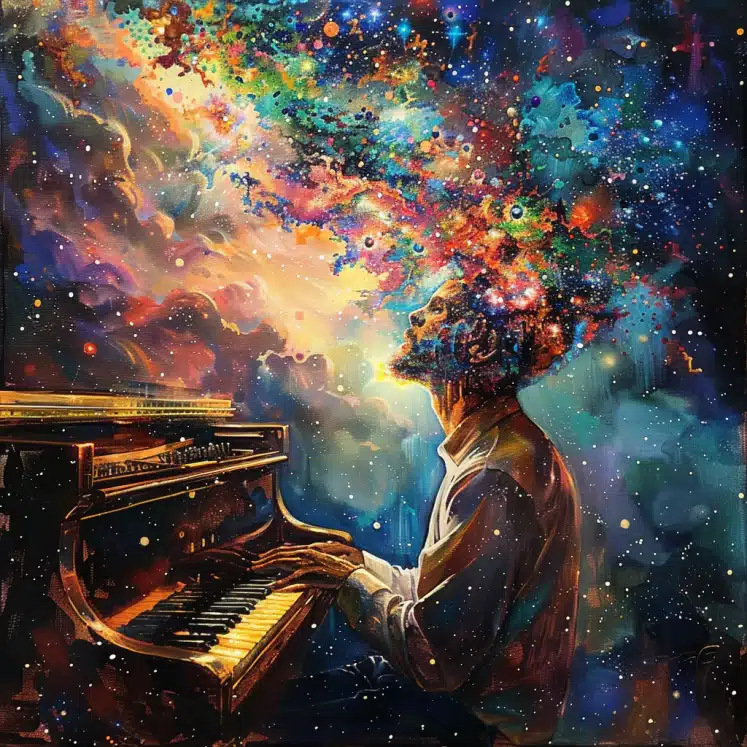Drug-induced musical hallucinations occur across various medical conditions, with antidepressants, opioids, and other medications as common triggers, potentially arising from neurotransmitter imbalances; treatment often involves modifying or discontinuing the trigger drug.
Highlights:
- Prevalence & Demographics: The average patient age was 58.3 years, with 67.9% being female.
- Common Conditions: Hearing impairments, psychiatric disorders, cancers, and neurodegenerative conditions were prevalent among those affected.
- Trigger Drugs: Antidepressants, opioids, anti-Parkinson drugs, ketamine, and voriconazole were frequently identified as trigger drugs.
- Onset & Symptoms: Symptoms appeared within a range of 75 minutes to 240 days after drug administration, with some patients experiencing concurrent visual hallucinations.
- Treatment & Outcomes: Treatment strategies included stopping or reducing the trigger drug, with 88.9% of patients experiencing complete resolution of hallucinations.
Source: Frontiers in Pharmacology (2024)
Major Findings: Drug-Induced Musical Hallucinations (2024)
1. Prevalence & Demographics
Age & Sex: The study found that the average age of patients experiencing drug-induced musical hallucinations was 58.3 years, with a range from 21 to 88 years old. Interestingly, the majority of these patients, about 67.9%, were female.
Implication: This suggests that older adults, particularly women, might be more susceptible to experiencing musical hallucinations when taking certain medications.
2. Common Associated Medical Conditions
Hearing Impairments: Approximately one-third (33.3%) of the patients had some form of hearing loss or reduced hearing. This is significant because hearing impairment might predispose individuals to hallucinate sounds, including music.
Psychiatric Disorders: Another third of the patients (33.3%) had psychiatric conditions such as depression, anxiety, bipolar disorder, or panic attacks. This suggests a strong link between mental health issues and the likelihood of experiencing musical hallucinations.
Other Conditions: Some patients had serious illnesses like cancers (25.9%) and neurodegenerative diseases such as Parkinson’s and Lewy Body Dementia (11.1%). These conditions could potentially interact with medications to trigger hallucinations.
3. Trigger Drugs Identified
Common Triggers: The study identified several types of drugs commonly associated with musical hallucinations.
- Antidepressants: Medications used to treat depression and other mood disorders.
- Opioids: Powerful painkillers often prescribed for severe pain.
- Anti-Parkinson Drugs: Medications used to manage Parkinson’s disease symptoms.
- Ketamine: A drug used for anesthesia and sometimes for pain and depression.
- Voriconazole: An antifungal medication.
Less Common Triggers: Other medications like benzodiazepines (used for anxiety and sleep disorders), certain antibiotics (like ceftazidime), and even vasodilators (drugs that widen blood vessels) were also linked to musical hallucinations.
4. Onset & Description of Symptoms
Time Frame for Onset: Symptoms of musical hallucinations could begin as quickly as 75 minutes after taking a drug, or they might not appear until as long as 240 days later. The average time to onset was about 21.4 days.
Variety in Hallucinations: The music hallucinated by patients varied widely. Some patients heard simple tunes or nursery rhymes, while others experienced complex orchestral pieces or popular songs from their youth. Six patients also reported seeing visual hallucinations along with hearing music.
5. Treatment Strategies & Outcomes
Effective Treatments: Most patients (88.9%) saw their hallucinations completely disappear when the trigger drug was either stopped or its dosage was reduced. In some cases, changing the form of the drug (e.g., from an intravenous to an oral route) or switching to a different but similar medication also helped.
Additional Medications: For some patients, adding medications like antidepressants, sedatives, or antipsychotics was necessary to stop the hallucinations.
Persistence of Symptoms: A small percentage (11.1%) of patients continued to experience musical hallucinations even after treatment, indicating that in some cases, the hallucinations could be more persistent or resistant to treatment.
Possible Mechanisms of Drug-Induced Musical Hallucinations
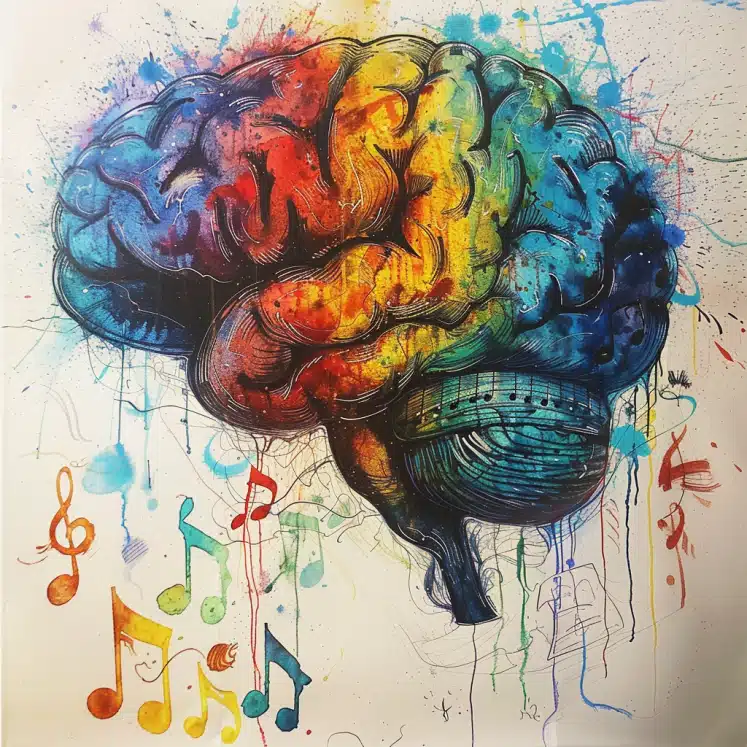
1. Neurotransmitter Imbalance
Dopamine Pathway Dysregulation: Many of the drugs implicated in causing musical hallucinations affect the brain’s dopamine pathways. For instance:
Opioids: Increase extracellular dopamine levels in the nucleus accumbens, potentially leading to overstimulation and hallucinations.
Antiparkinson Drugs: Elevate dopamine levels or activate dopamine receptors, which can disrupt normal auditory processing.
Antidepressants: Enhance functions of serotonin, norepinephrine, or dopamine, creating an imbalance that may result in auditory hallucinations.
2. GABAergic System Involvement
Benzodiazepines: These drugs enhance the inhibitory effect of gamma-aminobutyric acid (GABA) in the central nervous system. When their effect wears off or if the balance is disrupted (e.g., during withdrawal), it can lead to excitation in the auditory cortex, causing hallucinations.
Alcohol Withdrawal: Similar to benzodiazepines, alcohol withdrawal can lead to a rebound effect where the central nervous system becomes overexcited due to reduced GABAergic inhibition, potentially resulting in musical hallucinations.
3. NMDA Receptor Antagonism
Ketamine: This drug is an NMDA receptor antagonist, which means it blocks the NMDA receptors involved in synaptic plasticity and memory function. This blockage can cause dissociative states and hallucinations, including musical ones.
4. Drug Penetration into the CNS
Voriconazole: An antifungal drug that can cross the blood-brain barrier, reaching concentrations in brain tissue that exceed 50% of plasma levels. Its presence in the brain can lead to visual and auditory hallucinations.
Other Lipophilic Drugs: Drugs like ceftazidime, amiodarone, and dipyridamole, which are lipid-soluble, can penetrate the central nervous system and potentially disrupt normal auditory processing.
5. Auditory Cortex Stimulation
Aspirin Overdose: High doses of aspirin inhibit GABA transmission and stimulate the auditory pathway. This can lead to tinnitus and, in more severe cases, complex auditory hallucinations like musical hallucinations.
Drugs Most Likely to Cause Musical Hallucinations
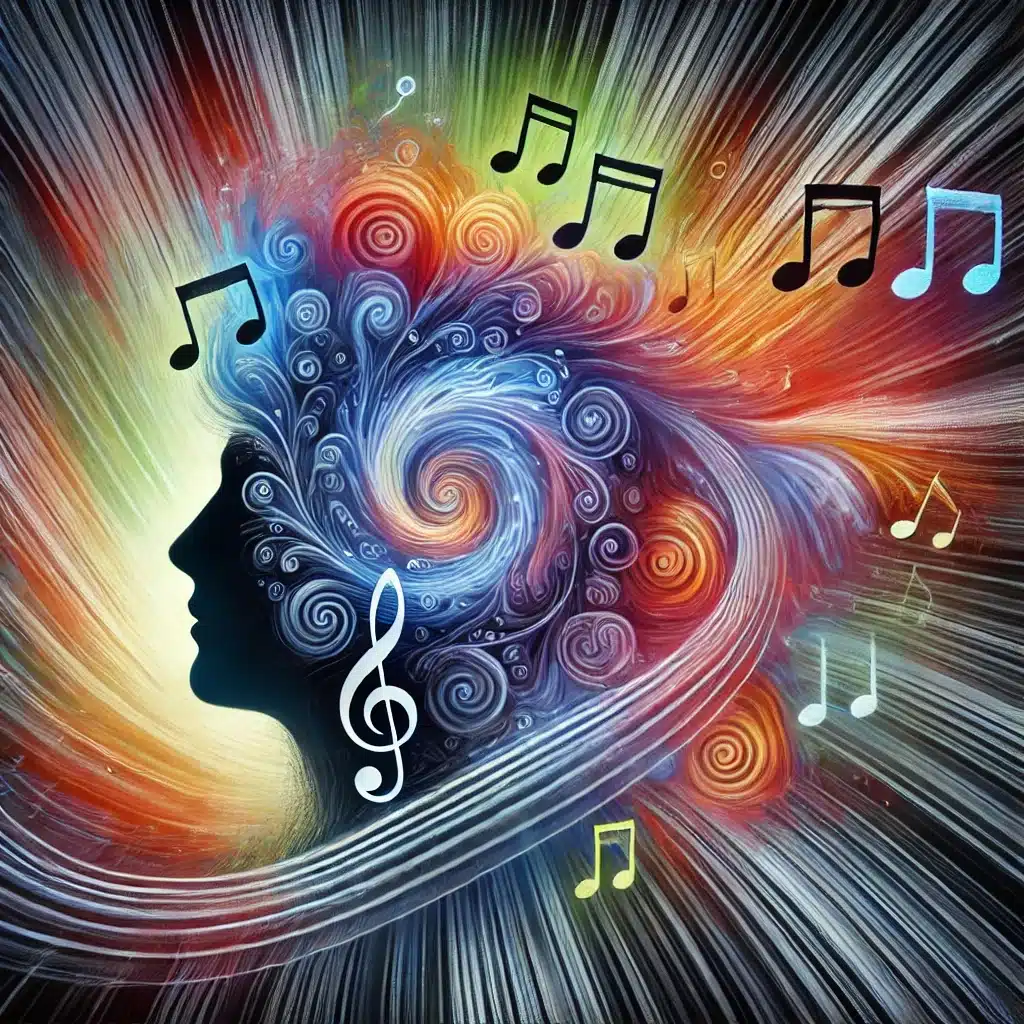
Antidepressants
Examples: Paroxetine, Mirtazapine, Imipramine, Clomipramine.
Mechanism: These drugs enhance the levels of serotonin, norepinephrine, and dopamine in the brain. An imbalance in these neurotransmitters, especially dopamine, can disrupt normal auditory processing and lead to hallucinations.
Opioids
Examples: Tramadol, Oxycodone, Morphine.
Mechanism: Opioids increase dopamine levels in the nucleus accumbens. This elevation in dopamine can lead to overstimulation of the auditory cortex, resulting in musical hallucinations.
Anti-Parkinson Drugs
Examples: Amantadine, Pramipexole, Bromocriptine.
Mechanism: These drugs increase dopamine levels or activate dopamine receptors. The elevated dopamine can disrupt normal brain function and cause hallucinations, including musical ones.
Ketamine
Mechanism: As an NMDA receptor antagonist, ketamine blocks NMDA receptors, leading to dissociative states and hallucinations, including music.
Voriconazole
Mechanism: This antifungal drug can cross the blood-brain barrier and reach high concentrations in the brain, potentially leading to visual and auditory hallucinations.
Benzodiazepines
Examples: Lorazepam, Temazepam, Lormetazepam.
Mechanism: These drugs enhance GABAergic inhibition in the brain. Disruption of this balance, particularly during withdrawal, can lead to excitatory states and hallucinations.
Other Drugs
Examples: Ceftazidime (antibiotic), Amiodarone (anti-arrhythmic), Dipyridamole (vasodilator), Pentoxifylline (vasodilator), Aspirin (NSAID).
Mechanism: These drugs, due to their lipid solubility, can penetrate the central nervous system and potentially disrupt normal auditory processing, leading to hallucinations.
Medical Conditions Linked to Musical Hallucinations
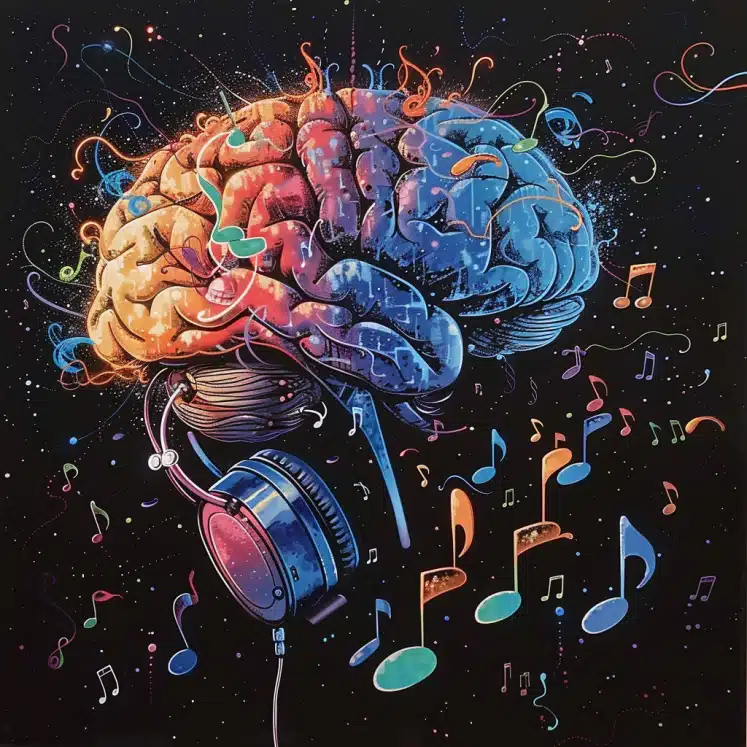
Hearing Impairment (Damage)
Prevalence: 33.3% of patients in the study.
Explanation: Hearing loss can reduce auditory input, causing the brain to compensate by generating its own sounds, which can manifest as musical hallucinations, especially when triggered by certain drugs.
Psychiatric Disorders
Prevalence: 33.3% of patients in the study.
Examples: Depression, Anxiety, Bipolar Disorder, Panic Attacks.
Explanation: Psychiatric disorders are linked with neurotransmitter imbalances, which can be exacerbated by medications, leading to hallucinations. Medications for these conditions often target serotonin, norepinephrine, and dopamine, further influencing auditory processing.
Cancers
Prevalence: 25.9% of patients in the study.
Explanation: Cancer treatments often involve drugs like voriconazole and ceftazidime, which can cross into the brain and induce hallucinations. The overall stress and physiological impact of cancer may also contribute to susceptibility.
Neurodegenerative Disorders
Prevalence: 11.1% of patients in the study.
Examples: Parkinson’s Disease, Lewy Body Dementia.
Explanation: These conditions involve a decrease in neurotransmitters such as dopamine. Drugs used to treat these disorders can further alter neurotransmitter levels, leading to hallucinations.
Other Conditions
Examples: Chronic Otitis, Osteoarthritis, Chronic Heart Failure, Chronic Renal Failure, Transient Ischemic Attack.
Explanation: These conditions might not directly cause hallucinations but can predispose individuals to the side effects of medications, including musical hallucinations.
Treatment Strategies for Drug-Induced Musical Hallucinations
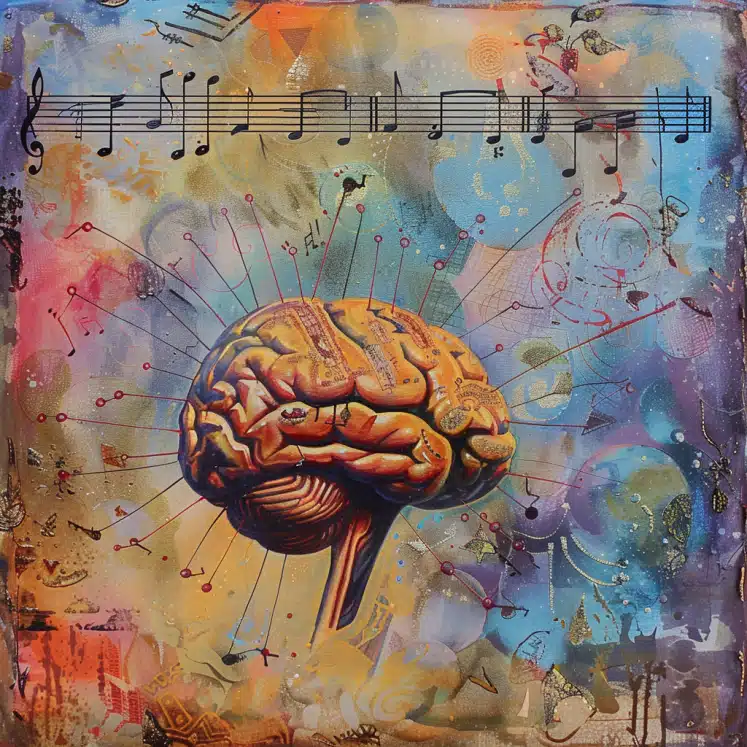
1. Termination of Trigger Drugs
- Strategy: Stopping the medication identified as causing the hallucinations.
- Effectiveness: This was the most effective strategy, with 40.7% of patients experiencing complete resolution of hallucinations.
- Details: When the offending drug is discontinued, the imbalance in neurotransmitter activity caused by the drug can gradually normalize, leading to the cessation of hallucinations.
2. Dose Reduction
- Strategy: Reducing the dosage of the trigger drug.
- Effectiveness: Effective in 14.8% of patients.
- Details: Lowering the dose can reduce the drug’s impact on neurotransmitter levels, thereby alleviating hallucinations without the need to completely stop the medication.
3. Alteration of Drug Administration
- Strategy: Changing the route or formulation of the drug.
- Effectiveness: Effective in 7.4% of patients.
- Details: Switching from intravenous to oral administration or from extended-release to immediate-release formulations can help mitigate the drug’s impact on the brain, reducing the risk of hallucinations.
4. Switching to Similar Drugs
- Strategy: Replacing the trigger drug with another drug that has a similar therapeutic effect but a lower risk of causing hallucinations.
- Effectiveness: Effective in 7.4% of patients.
- Details: For example, switching from one anti-Parkinson drug to another or from one sedative to another can help manage the primary condition while avoiding the side effect of hallucinations.
5. Addition of Other Medications
- Strategy: Adding medications like antidepressants, sedatives, or atypical antipsychotics to manage hallucinations.
- Effectiveness: Effective in 11.1% of patients.
- Details: These medications can help rebalance neurotransmitter levels or reduce excitatory activity in the brain, thereby alleviating hallucinations.
6. Benzodiazepines for Alcohol Withdrawal
- Strategy: Using benzodiazepines to manage hallucinations caused by alcohol withdrawal.
- Effectiveness: Effective in 3.7% of patients.
- Details: Benzodiazepines enhance GABAergic inhibition, counteracting the excitatory rebound effect of alcohol withdrawal and reducing hallucinations.
How long does treatment take to work for musical hallucinations?
Resolution of Hallucinations: 88.9% of patients experienced complete resolution of their musical hallucinations following these treatment strategies.
Time to Resolution: The average time for hallucinations to stop was 5.6 days, with a range from 75 minutes to 21 days.
Persistent Cases: In 11.1% of patients, musical hallucinations were reduced but continued despite treatment, often due to underlying conditions like psychiatric disorders or hearing impairments.
Drug-Induced Music Hallucinations (Review of Cases)
The primary aim of this study was to investigate drug-induced musical hallucinations, focusing on their pathophysiology and potential treatment modalities.
Researchers sought to understand how certain drugs can trigger musical hallucinations and to explore effective strategies for managing these symptoms.
Sample
The study included 27 documented cases of drug-induced musical hallucinations, analyzed from 24 articles that met the inclusion criteria.
The patients ranged in age from 21 to 88 years, with an average age of 58.3 years.
The sample comprised 67.9% females.
Methods
- Literature Review: A comprehensive literature search was conducted across four databases: PubMed, WorldCat, Google Scholar, and Directory of Open Access Journals (DOAJ). The search included keywords like “drugs induced musical hallucination” or “drugs” combined with “musical hallucination.”
- Inclusion Criteria: Articles were included if they detailed cases of auditory hallucinations involving music, identified trigger drugs, and provided detailed patient information. Only publications in English were considered.
- Data Extraction: Information was extracted on patient demographics, background conditions, trigger drugs, description of hallucinations, onset time, and treatment outcomes.
Limitations
- Lack of Clinical Trials: The study highlighted the absence of placebo-controlled clinical trials specifically investigating drug-induced musical hallucinations, limiting the ability to establish causative effects definitively.
- Low Incidence Rate: The rarity of drug-induced musical hallucinations poses challenges in estimating their prevalence and makes it difficult to generalize findings.
- Potential Bias: The inclusion of only detailed case reports may introduce bias, as cases without comprehensive data were excluded, potentially overlooking other relevant trigger drugs.
- Observational Nature: The observational design of the study limits the ability to draw strong correlations or causal inferences between drug use and musical hallucinations.
Conclusion: Drug-Induced Musical Hallucinations
This study provides valuable insights into the rare phenomenon of drug-induced musical hallucinations, highlighting the significant role that certain medications and underlying medical conditions play in their occurrence.
By analyzing 27 documented cases, the research underscores the prevalence of these hallucinations in older adults, particularly women, and identifies common triggers such as antidepressants, opioids, and anti-Parkinson drugs.
Effective treatment strategies, including the termination or reduction of the trigger drugs, were shown to resolve hallucinations in the majority of cases.
Despite the lack of placebo-controlled trials, the findings emphasize the need for heightened awareness among healthcare providers to recognize and address this condition promptly.
Further research is essential to elucidate the exact mechanisms underlying drug-induced musical hallucinations and to develop more targeted therapeutic interventions.
References
- Study: Drug-induced musical hallucination (2024)
- Authors: Brock Bakewell et al.
